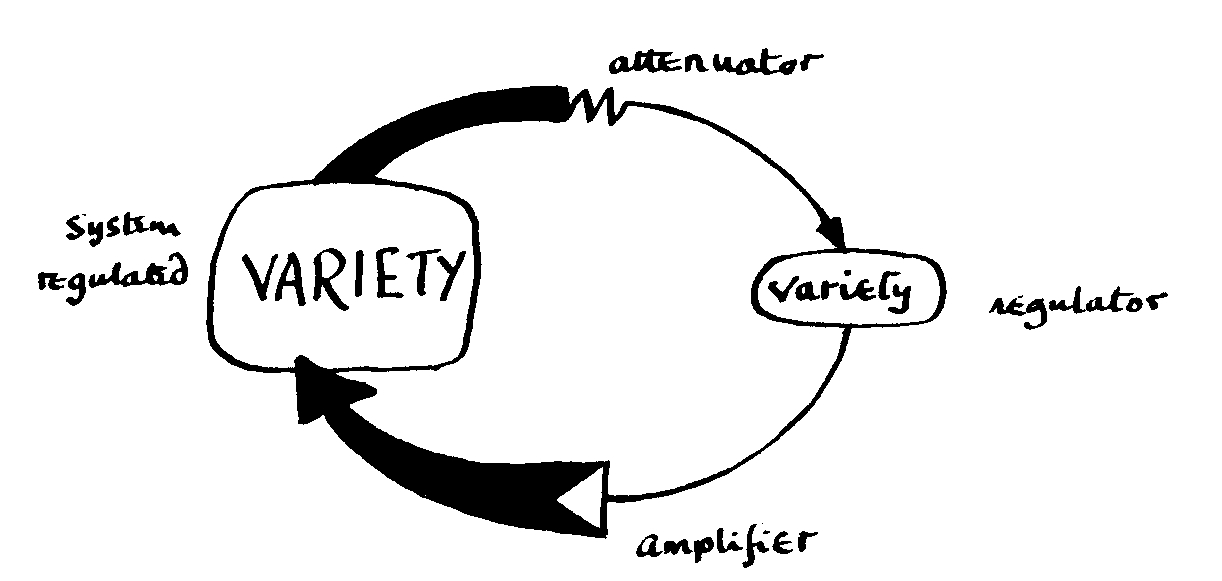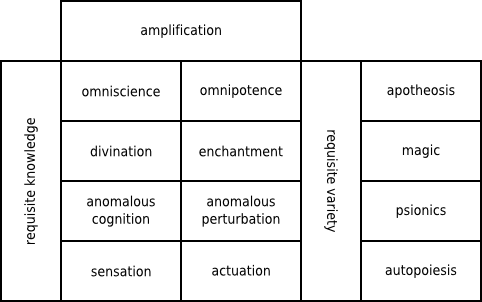de alchemia cybernetica
This work is a stream of synthetic correspondences between alchemy and cybernetics, which informed some of the ideas going into Oneirodyne Systems and hyperRitual. It is intended to stir the reader's imagination, not to demonstrate anything analytically or academically. In retrospect, some of the associations may appear naive, but such is a pebble upon which has been written a record of the past, in the stream of learning.
introductio

[…] there exists in Nature a force which is immeasurably more powerful than steam, and a single man, who is able to adapt and direct it, might change thereby the face of the whole world. This force was known to the ancients; it consists in a Universal Agent having equilibrium for its supreme law […] — Eliphas LÚvi, Dogme et Rituel de la Haute Magie (Transcendental Magic, Its Doctrine and Ritual)
[…] one thing is abundantly clear; all serious writers, though they seem to speak of an infinity of different subjects, so much so that it has proved impossible for modern analytic research to ascertain the true nature of any single process, were agreed on the fundamental theory on which they based their practices. […] Yet beneath this diversity, we may perceive an obscure identity. They all begin with a substance in nature which is described as existing almost everywhere, and as universally esteemed of no value. The alchemist is in all cases to take this substance, and subject it to a series of operations. By so doing, he obtains his product. This product, however named or described, is always a substance which represents the truth or perfection of the original "First Matter"; and its qualities are invariably such as pertain to a living being, not to an inanimate mass. In a word, the alchemist is to take a dead thing, impure, valueless, and powerless, and transform it into a live thing, active, invaluable and thaumaturgic. — Aleister Crowley, "Chapter 20. Of the Eucharist and of the Art of Alchemy," Magick in Theory and Practice
Every process produces a product. Every product is produced by a process. — Gordon Pask
One interpretation of the mass of circles and lines at the center of the above mandala is an alchemical symbol for the Philosopher's Stone, the finding of which is the penultimate task in the alchemist's Great Work (Magnum opus). It unites (certain qualities of) Sulfur, Salt, and Mercury under time. As you study the symbol, you may re/cognize how your re/cognition of its components (sub-symbols) competes or cooperates with your re/cognition of the symbol as a unity having its own definition that exceeds the sum of its sub-symbols' definitions (cf. the state space of the Philosopher's Stone, which is greater than the sum of state spaces of sulfur, salt, and mercury).
The symbol that may appear as a crowned lizard eating its tail ("Now the serpent was more subtil than any beast of the field which the LORD God had made" — Genesis 3:1, King James Bible), is the ouroboros ("tail-devourer"), and may re/present circularity (cf. enso) and the union of opposites (as the tail is consumed by the head, making one indistinguishable from the other — "a circle begins where it ends"). For the alchemist, it may re/present the cycle of birth-and-death she seeks liberation from (cf. samsara), the conjunction of solution and coagulation (i.e., the et of solve et coagula), and the "All Is One" (hen to pan, lit. "the one, the all"). For the cybernetician:
Should one name one central concept, a first principle of cybernetics, it would be circularity. Circularity as it appears in the circular flow of signals in organizationally closed systems, or in "circular causality," that is, in processes in which ultimately a state reproduces itself. — Heinz von Foerster
The realization that the observer, the observed phenomenon, and the process of observation itself form a totality [cf. the inside, outside, and boundary itself, of a circle /jam], which can be decomposed into its elements [cf. nigredo and solve /jam] only on pain of absurd reifications, has far-reaching implications for our understanding of man and his problems — especially of the ways in which he literally "constructs" his reality, then reacts to it as if it existed independently of him "out there," and eventually may arrive at the startling awareness that his reactions are both the effect and the cause of his reality construction. This "curved space" of human experience of the world and of himself, this closure — as Heinz von Foerster calls it — finds its symbolic expression in the Ouroboros, the snake that bites its own tail, or its poetic expression in the words of T. S. Eliot, for whom "The end of all our exploring will be to arrive where we started and know the place for the first time." — Paul Watzlawick, foreword to Lynn Segal's The Dream of Reality: Heinz von Foerster's Constructivism (emphasis in original)
Compare Eliot's line in the above quote to the Buddhist Nirvana, which is by some accounts a heavenly palace, and by others the ordinary world where-when-in the observer, having realized her Buddha-nature, operates free of karmaic bondage (cf. King James Bible, Luke 17:21: "Neither shall they say, Lo here! or, lo there! for, behold, the kingdom of God is within you"). Compare also the two suns in alchemy: one black (Sol niger) and material, re/presenting the beginning (nigredo) of the Great Work; the other white or golden, and ethereal, re/presenting culmination of the Work.
Ouroboros may also re/present a feedback loop, where-when part of the output (tail) of a process is returned to the process' input (mouth). Negative and positive feedback (see also Part 5) correspond to the attenuation and amplification of knowledge and variety, which conserve a system's autopoiesis.

The above is a feedback diagram from Ernst von Glasersfeld's Radical Constructivism: A Way of Knowing and Learning. The main difference between this and other, similar feedback diagrams, is that sensation and action occur within the organism's closure: "From the constructivist perspective, 'input' is of course not what an external agent or world puts in, but what the system experiences" (p. 151).

The above drawing is from Stafford Beer's Designing Freedom, and illustrates the relationship between requisite variety in a regulating system, and requisite variety in the system being regulated.
The dynamic of contemplation normally requires that we do not dwell on the visible things but rather pass on to the inner world. We do not need a concrete vision, focused on appearance and material details, but a spiritual one, where imagination tries to apprehend the invisible beyond the corporeal. This may be easier when we reach to our innermost experience. But hermetism has worked out a method which enables us to go much further by transcending the limit that we always set between us and the others, inside and outside, present, past and future, our individual being and the immensity of the universe.
This method which is called 'becoming Aiôn' (eternal) […] — Clement Salaman et al, "Introduction (to The Definitions of Hermes Trismegistus to Asclepius)," The Way of Hermes (my emphasis)
Where man's word goes, and where his power of perception goes, to that point his control and in a sense his physical existence is extended. To see and give commands to the whole world is almost the same as being everywhere. — Norbert Wiener, The Human Use of Human Beings: Cybernetics and Society
The attempt to become a god is the Great Work of magic and alchemy. — Richard Cavendish, The Black Arts
We understand God in the spirit of pantheism. God is the highest level of control in the Universe. God is for the Universe what human will is for human body. Natural laws are one of the manifestations of God's will. Another manifestation is the evolution of the Universe: the Evolution. — Principia Cybernetica: The Cybernetic Manifesto: God
author: joshua madara
